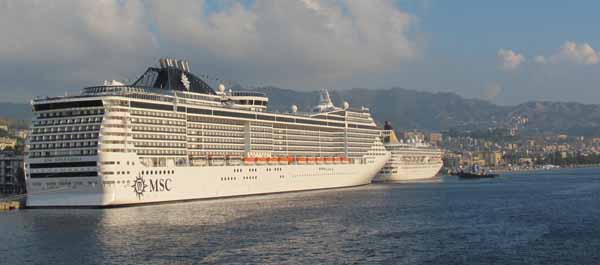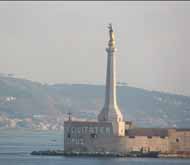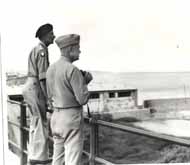A Journey to World War II Battlefields Part 6: The Great Escape

Editor’s Note: This article is the sixth installment in a series on World War II battlefields by Carlo D’Este. Please click on the following links to read Carlo’s other articles from this series Tunisia, Kasserine Pass, Malta, Sicily and Biazza Ridge.
{default}Our final destination in Sicily was the port city of Messina. Situated on the northeastern tip of the island, Messina was completely destroyed during the fighting in August 1943. The city possessed both a strategic location but also a natural deep-water harbor that had for centuries attracted mariners.
An ancient city founded by Greek colonists in the 8th century BC and originally called Zancle, it was renamed Messene in the 5th century BC for the Greek city of the same name. The city has a turbulent history of conquest and at various times has been subjugated by the Carthaginians, the Mamertines, and after the fall of the Roman Empire by the Goths, the Byzantines, the Normans, and the Spanish.
The Black Death is thought to have invaded Europe through Messina. Earthquakes have plagued the city: In 1783, it was mostly destroyed and this was followed by a devastating earthquake and subsequent tsunami that virtually destroyed Messina, killing some 60,000 people. Further devastation rocked the city in 1943 when it was again pounded into rubble by massive Allied air raids.
Militarily, Messina was a key strategic goal of the Allies in 1943, one that was implied but never articulated by the allied ground commander-in-chief, Gen. Sir Harold Alexander.
 The Sicily campaign was one of the shortest of the war fought by the western allies. But it was by no means any less bloody. The strongest resistance in Sicily came from a German army corps, General der Panzertruppen Hans Valentin Hube’s XIV Panzer Corps, which fought tenaciously, giving up ground only grudgingly and always maintaining maximum resistance and inflicting heavy allied casualties before retreating to new positions. Their mastery of effectively defending terrain was never more evident than in Sicily.
The Sicily campaign was one of the shortest of the war fought by the western allies. But it was by no means any less bloody. The strongest resistance in Sicily came from a German army corps, General der Panzertruppen Hans Valentin Hube’s XIV Panzer Corps, which fought tenaciously, giving up ground only grudgingly and always maintaining maximum resistance and inflicting heavy allied casualties before retreating to new positions. Their mastery of effectively defending terrain was never more evident than in Sicily.
However, by early August, Axis forces were being inexorably squeezed into smaller and smaller pockets in the northeastern corner of the island. It was starkly clear to both the German and Italian commanders that they would either have to evacuate their forces to mainland Italy or face certain defeat and capture.
From the time of the Axis defeat in Tunisia in May 1943, German attention had begun to focus on the lifeline between Sicily and Italy: the Messina Strait. That same month, to organize, coordinate and command the movement of men and materiel from Italy to Sicily the Germans appointed a brilliant and experienced naval officer, Captain (Baron) Gustav von Liebenstein, who quickly determined that he had inherited a confusing and disparate group of sea transport units under the control of the Luftwaffe, the Navy, German Army engineers, even the infantry. He immediately set about reorganizing these units under his direct control and into an efficient ferry service whose object was to quickly and efficiently move men and material across the Strait of Messina from Reggio di Calabria, the principal city in the “boot” of Italy.
Von Liebenstein’s “navy” consisted of a number of specialized vessels, the most important of which were called Siebel ferries: a crude but effective makeshift combination of two engineer pontoons held together by steel girders over which was laid a platform to carry vehicles and troops. Originally designed by aircraft designer Fritz Siebel for Operation Sea Lion, the proposed but never implemented German invasion of Britain in 1940, the Siebel ferry became the workhorse of the Messina Strait. Other specialized vessels were flat-bottomed barges, tanker and freight barges and some Siebel ferries that were converted into deadly floating flak vessels.
Very early in the Sicily campaign Messina and the Strait became targets of the allied air forces. Despite frequent and enormous air raids, the Allies did considerable damage to Messina but failed to disrupt von Liebenstein’s efficient ferry service. The AA defenses of the Strait of Messina were the most concentrated, deadly and effective in the Mediterranean and it did not take long for the allies to become extremely wary of the dangerous welcome that awaited them each time they attacked.
The German commander-in-chief in the Mediterranean, Field Marshal Albert Kesselring, was determined that there be no repeat of the disastrous losses which befell the Germans in Tunisia. By the end of July plans were in full swing for an evacuation to mainland Italy.
The German evacuation plan was based on the simple premise that the first priority must be to save troops, followed by as much equipment, ammunition and supplies as could be moved across the Strait. Anything immovable was to be destroyed.
As Gen. Hube was masterminding a brilliant strategy of phased withdrawals into northeastern Sicily that eventually converged on Messina, von Liebenstein was refining his plans for the naval operation to extract Hube’s troops to mainland Italy. At the same time the Italian Army was planning its own evacuation across the Strait.
While Hitler dithered over giving the order to evacuate, Kesselring took matters into his own hands and independently ordered the evacuation to commence. By the time Hitler finally got around to authorizing it on August 16 the evacuation was already complete.
During the period from July 31 to August 10, the Allied air forces flew 528 sorties against targets in the Messina Strait, dropping 1,217 tons of bombs and doing very little damage. These raids failed to disrupt the evacuation that continued without interruption. During this period the Germans reported the loss of one Siebel ferry, one landing craft, one flak boat and two oil lighters.
The evacuation was so efficient that von Liebenstein guaranteed Hube he could move 12,500 men per twenty-four hour period but was only prevented from doing so only because the Army could not deliver that many troops each day.
The evacuation continued day and night, with the greatest success during daylight hours. The operation was intended to last only five days but was so successful that it was extended for an extra day in order to complete the withdrawal of equipment.
By the morning of August 16 all but the rearguard elements defending the final line outside Messina had been safely evacuated from Sicily. What was originally an operation that would likely end in disaster instead became a stunning success. Von Liebenstein later noted that the Army had never taxed his ferry service to its capacity.
Although they would later claim differently, the Allied air forces failed to make any semblance of a determined effort to halt the evacuation until the final three days. By then it was a case of too little, too late, with minimal results. On August 15 and 16, two daylight raids by ninety-five bombers and 485 fighters and fighter-bombers that dropped 154 tons of explosives failed to sink a single Axis vessel.
Likewise, the naval commander-in-chief, British Admiral Sir Andrew Cunningham, made no serious effort to interdict the Strait of Messina with Allied naval forces. Perhaps it was memories of the Royal Navy at disastrous operation in the Dardanelles in 1915, where he served as a young destroyer captain, that deterred Cunningham and other senior British sailors. About the only Allied vessels to operate in the Strait were a few British motor torpedo boats and motor gunboats – a veritable needle in a haystack.
The aggressive spirit the Allied naval and air forces had shown in Tunisia had by August 1943 given way to a state of mind that charitably could only be described as half-hearted. Neither had a plan for attacking the evacuation, which was further bungled by faulty intelligence that never grasped the full implication of what the Germans and Italians were doing. What later became clear was that neither force was willing to take on the ferocious Axis defenses of the Strait of Messina.
The evacuation culminated the night of August 16/17 when the last movable equipment and the remaining German rearguard troops were safely taken off the island.
In all, von Liebenstein’s incredibly efficient ferry service resulted in the successful evacuation of 39,951 troops, 9,789 vehicles, 51 tanks, 163 guns, 1,874 tons of ammunition, and 16,791 tons of equipment.
At the same time, the Italians were carrying out their own hugely successful evacuation from Sicily to Calabria: 59,000 troops, 3,000 sailors, 227 vehicles, forty-one artillery pieces and twelve mules without the loss of a single man. Although the surrender of Italy on September 8 would keep the Italian army from fighting the Allies in Italy, the German evacuation would soon have disastrous consequences in the long campaign ahead.
 When the first allied troops of the U.S. Third Infantry Division entered the ruined city of Messina the evening of August 16 they found the city all but abandoned and the last of the German army long gone. Von Liebenstein would later proudly state that: “We have not given up a single German soldier, weapon or vehicle into enemy hands.”
When the first allied troops of the U.S. Third Infantry Division entered the ruined city of Messina the evening of August 16 they found the city all but abandoned and the last of the German army long gone. Von Liebenstein would later proudly state that: “We have not given up a single German soldier, weapon or vehicle into enemy hands.”
At Dunkirk, British ingenuity and grit had saved the BEF but not its precious equipment. In Sicily, the Germans had saved not only themselves but virtually everything capable of being ferried to the mainland. Only those captured and the dead were left behind.
Ever defiant to the end, the Germans came away from Sicily feeling they had given as good as they had got. From the outset, the Germans, not the Allies, had been in real control of the timetable for the Sicily campaign. By constantly delaying and making maximum use of the terrain against nearly impossible odds, the German army had performed admirably against superior air, sea and ground forces. At the end they added the final insult by their brilliant planning and execution of the great escape.
The Allies should have ended the Sicily campaign with a stunning victory; instead, by any objective assessment, they gathered a harvest of bitter fruit. They would pay a high price for their ineptitude during the Italian campaign.
A full account of the great escape and its consequences can be found in the author’s Bitter Victory: The Battle for Sicily, 1943.


Battle of the Straits of Messina: the greatest Allied defeat of WWII.
Think Singapore II: a huge navy defeated by a tiny army.
-dlj.